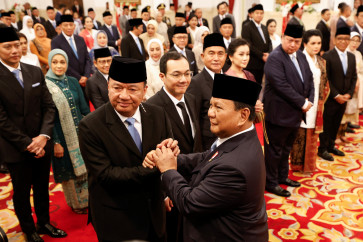Sticker book reveals city's culture, nonsensicalness
What do stickers say about a city? Ubiquitous as they are, the often disregarded pieces of visual art are a telltale sign of the profane, the sacred to the downright nonsense of the city
Change text size
Gift Premium Articles
to Anyone

What do stickers say about a city? Ubiquitous as they are, the often disregarded pieces of visual art are a telltale sign of the profane, the sacred to the downright nonsense of the city.
Four researchers from Ruangrupa, a contemporary art organization, set out to compile all of Jakarta's commonly seen stickers into a book titled Stiker Kota (Sticker City). The 299-page book is the first to be published by Ruangrupa's research and development division, which focuses on art and visual culture.
Head of the division, Ugent T. Moetidjo, worked with Ruangrupa founder Ade Darmawan, chief editor of online magazine karbonjournal Ardi Yunanto and researcher Mirwan Adnan to produce the book.
The four collected thousands of stickers between June and November 2008 and classified them into two big categories: the "free" and the "proper".
The "free" stickers include humorous pictures, funny catchphrases, puns and erotic pictures. Examples of these common tones can be seen in the variety of Che Ghuevara stickers. One sticker has Jakarta comedian Benyamin Sueb's face interposed in Che's hair and beret, another shows a woman's face in the same style with the words Chewe Gueparah written under it. Chewe Gueparah is a pun, which loosely translates to "my girl is really bad".
"Proper" stickers include religious stickers and words of good advice. Examples are the Arabic writing of Allah and Muhammad, verses of the Qur'an, prayers and pictures of Jesus.
From the stickers shown in the book we can see that sticker producers like to play with words and pictures, juxtaposing anything from Disney character Mickey Mouse to pictures of sexy women in calendars with words.
Ade Darmawan said that in the religious stickers, the producers also had fun, putting Disney characters like Winnie the Pooh on a sticker with writing in Arabic saying, "Allah is great".
"People would wonder, "Since when did Winnie the Pooh became a Muslim?" Ade said jokingly, in a discussion during the book launch.
Text stickers sometimes have phrases that made no sense, such as a text sticker saying, "Yang gila tidak mendapatkan rasa protes", which translates as "Whose crazy does not get a feel for protest".
The authors said that they thought the sticker was the funniest because of its nonsensicalness.
The book is a testament to the authors' meticulousness in compiling and sorting thousands of stickers. The authors also tracked down the oldest sticker factory, AMP (Adi Mas Production), in Pakisaji kampong in Malang regency, East Java. Discovering that a factory in a small village produces stickers that are distributed city-wide surprised the authors.
Critics however, said that the book lacked analysis on the reading of the stickers. In the discussion, cultural observer Bambang Sugiharto said that there were many approaches for analysis, from semiotic, audience research and post-modernist approaches to identity discourse, none of which the authors engaged in.
Film maker and activist Lisabona Rachman also questioned the authors' hesitation in classifying the stickers in a more rigid way, which would make it easier for readers to make sense of the jumble of stickers in the city.
The authors included an essay in the book, which gave their thoughts behind the system of classification. However, the images of the stickers themselves were displayed in the book without classification.
The authors responded that they were overwhelmed with the plethora of stickers and the jumble of meaning that the stickers might represent.
The critics agreed that the book was a good start for a deeper analysis on stickers. In the mean time, the book is interesting enough as it has abundant images of quirky stickers.









